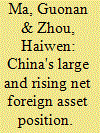| Srl | Item |
| 1 |
ID:
090934


|
|
|
|
|
| Publication |
2009.
|
| Summary/Abstract |
China's emergence as a major player in world trade is well known, but its growing role in global finance might have been underappreciated. China is the second largest creditor in the world today, with a net creditor position of 30 percent of GDP in 2008. We test the importance of the growth differential, demographics, government debt, financial depth and the exchange rate in shaping China's net foreign asset position. Our empirical results highlight the sharp fall in the young-age dependence as one key driver behind China's puzzlingly large net lender position and also confirm the neoclassical prediction that faster growth attracts more capital inflows. Looking ahead, our findings suggest that China will unlikely turn into a meaningful net debtor nation over the next two decades.
|
|
|
|
|
|
|
|
|
|
|
|
|
|
|
|
| 2 |
ID:
164424


|
|
|
|
|
| Summary/Abstract |
This article studies the impact of age structure variables on the current account balance (CAB) by using panel data for 57 countries from 1980 to 2014. The Gudmundsson and Zoega (Economic Letters 123[2]:183–186, 2014) methodology is used to calculate the age-adjusted CAB for these countries and India-specific results are analysed in comparison with Brazil, Russia, China and South Africa. Empirical results show that India’s age-adjusted CAB would have experienced surpluses had it not been for the high share of its dependent population, especially the young. Further, the age-adjustment factor for India shows a gradual decline, and a larger share of working-age population in future may help in reducing its current account deficit (CAD). These results highlight the importance of demographic variables in explaining and predicting changes in the CAB and its implication for the attainment of India’s macroeconomic objective of external stabilisation.
|
|
|
|
|
|
|
|
|
|
|
|
|
|
|
|